Baggage Handling eTool

Baggage Handling » Ticket Counter (Check-In Area)
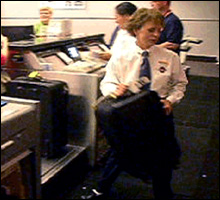
Ticket agents generally encounter hazards while working at a computer workstation and while transferring baggage. Agents often stand at a computer workstation for long periods of time, which may result in fatigue and awkward postures. They also retrieve, weigh, and tag the passenger baggage as well as move it onto a feeder conveyer. Lifting heavy or awkward baggage can lead to various ergonomic hazards resulting in injuries. However, these hazards may be avoided by implementing simple controls in the following areas:
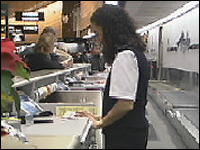
Potential Hazards
-
Standing on hard floors or sitting for long periods of time can fatigue the back and leg muscles.
-
Working while assuming awkward neck and wrist postures can cause discomfort and may lead to musculoskeletal disorders (MSDs). (Figure 1)
Possible Solutions
-
Perform stretching exercises that help loosen and relax the muscles and joints.
-
Wear comfortable and supportive shoes (no higher than 1.5" heel height).
-

Provide anti-fatigue mats for ticket agents who must stand for extended periods of time. (Figure 2)
-
Provide footrests that are 4 - 6 inches from the floor. This will allow the ticket agent to alternate the leg that supports the majority of his or her weight and allows employee to frequently change posture throughout shift.
-
Provide sit/stand stools that allow ticket agents to change postures while working behind the counter.
Potential Hazards
-
Awkward neck and wrist postures from using monitors (VDTs), keyboards, and mouse devices that are placed too low may create stress in the joints and muscles.
-
Contact stress to wrists may result from contact with counter edges.
-
Extended or repetitive reaches across the counter to retrieve items from passengers (bag tags, boarding cards, etc.) or to lift or tag baggage can cause back and shoulder injuries. (Figure 3)

Possible Solutions
-
Perform stretching exercises that help loosen and relax the muscles and joints.
-
Provide wrist rests or add padding to counter edges to soften contact points between the ticket agent and the workstation.
-
Ensure the printer is placed at an appropriate height and in front of the agent to reduce bending and twisting motions.
- Modify the workstation to ensure monitor, keyboard, and mouse are height adjustable, allowing ticket agents to change their working postures.
- This helps ticket agents of different heights to maintain neutral body postures while working at various ticket counters.
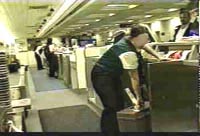
Potential Hazards
-
Bending over to tag or lift baggage. (Figure 4)
-
Lifting baggage by the handle with one hand causes unequal distribution of the load and may fatigue grip strength and stress the back and shoulders.
-
Twisting the torso while transferring baggage to the main conveyor, often several feet behind the counter. (Figure 5)
-
Reaching with extended arms to lift and carry baggage.
-
Dangling baggage straps that may get caught in the belts or on corners.
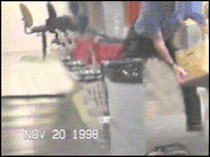
Possible Solutions
-
Educate agents about proper body mechanics to increase awareness of good work practices.
-
Perform stretching exercises that help loosen and relax the muscles and joints.
-
Tag baggage while it is in the bagwell to avoid repeatedly lifting it to a temporary position on the floor and then lifting it again to the main conveyor.
-
Tag excessively heavy baggage and get help from another person or use a lifting aid when handling baggage with heavy bag tags. (Figure 6)
-
Use a rotation scheme to rotate agents out of a task that is particularly stressful. This gives the body valuable rest and recovery time.
-
Raise the height of bagwells a couple inches above the take-away belts to minimize bending.
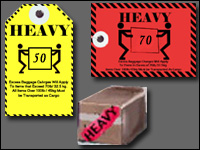
Potential Hazards
-
Lifting with arms fully extended.
-
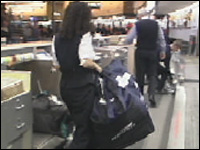
Lifting excessively heavy or oddly shaped baggage. (Figure 7)
-
Lifting bags from the ground while standing in bagwell when assisting passengers.
Possible Solutions
-
Ensure that the passenger places baggage in the bagwell so the ticket agent does not have to bend over the counter to retrieve it.
-
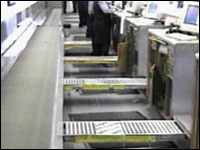
Use a "roller conveyor" or a metal slide to reduce the forces associated with lifting. Sliding an object is usually preferable to lifting. (Figure 8)
-
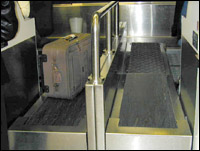
Use an automated conveyor system that eliminates the need for lifting baggage and reduces the number of hazards associated with lifting. (Figure 9)

